Abstract
Maxillaria andina, a new orchid species from high-Andean ecosystems of southwestern Colombia and northern Ecuador, is described. The new species is distinguished by having long and narrowly linear white sepals and petals with revolute margins, lip with mucronate epichile, and callus without hairs or trichomes. Distinguishing characters are provided to differentiate it from morphologically similar species, along with ecological and taxonomical notes. Additionally, Maxillaria sibundoyensis is synonymized with Maxillaria floribunda.
Keywords: Colombia; Ecuador; high-Andean ecosystems; Neotropical flora; taxonomy
Resumen
Maxillaria andina, una nueva especie de orquídea de ecosistemas altoandinos del suroccidente de Colombia y norte de Ecuador, es descrita. La nueva especie se distingue por presentar sépalos y pétalos blancos, largos y estrechamente lineales, con los márgenes revolutos, el labelo con un epiquilo mucronado y el callo sin pelos ni tricomas. Presentamos caracteres distintivos que diferencian a la nueva especie de sus especies morfológicamente similares, así como notas ecológicas y taxonómicas. Adicionalmente, Maxillaria sibundoyensis es sinonimizada con Maxillaria floribunda.
Palabras clave: Colombia; ecosistemas altoandinos; Ecuador; flora neotropical; taxonomía
Introduction
Maxillaria Ruiz & Pav. sensu lato is one of the most diverse orchid genera in the world, embracing about 651 species (Christenson et al. 2012, Engels & Smidt 2023, Lipińska et al. 2022, Schuiteman & Chase 2015, Whitten et al. 2007). Plants of Maxillaria grow as epiphytes, lithophytes, or terrestrials in cloudy, wet, or more rarely in seasonally dry forests, from the United States (Florida) and Mexico to northern Argentina, including the Antilles (Schuiteman & Chase 2015). In last decades, the circumscription of Maxillaria has been a subject of controversy (Barros 2002, Blanco et al. 2007, Dressler 1993, Ojeda et al. 2005, Szlachetko et al. 2006, Szlachetko & Miszek 2007, Whitten et al. 2007, Whitten & Blanco 2011); it was divided into 17 genera (Blanco et al. 2007), later expanded into 37 genera (Szlachetko et al. 2012), but has recently been lumped into a single genus, including other genera that no previous authors had synonymized with Maxillaria sensu lato (Schuiteman & Chase 2015). This new reclassification includes the genus Chrysocycnis Linden & Rchb.f., Cryptocentrum Benth., Cyrtidiorchis Rauschert, Mormolyca Fenzl, Pityphyllum Schltr., and Trigonidium Lindl. According to Schuiteman and Chase (2015), Maxillaria groups species with single-flowered inflorescences, sepals, and petals free or partially fused, with a free labellum articulated at the base of the stout column or rigidly fused to the column foot, and conduplicate leaves (Moreno et al. 2017, Schuiteman & Chase 2015, Zambrano-Romero & Solano-Gomez 2016).
The Andean countries of northern South America are the richest in Maxillaria species. Colombia and Ecuador together have more than 400 species recorded (Govaerts et al. 2021, Ortiz Valdivieso & Uribe Vélez 2007), with several new species discovered and described in the last years (Moreno et al. 2017, Szlachetko et al. 2017, Zambrano-Romero et al. 2020; Lipińska et al. 2022). Nonetheless, taxonomic studies for Maxillaria remain scarce in both countries, and new species can still be found (Zambrano-Romero & Solano-Gómez 2016). Recent explorations conducted in the last few years in the Andes of southwestern Colombia and northern Ecuador expanded our knowledge of orchid diversity, notably in the poorly studied Puracé National Natural Park (PNNP), where two new species of orchids have been described in recent years (Moreno et al. 2020). In the latest expeditions in Colombia and Ecuador, we found two populations of a morphologically distinctive species from the genus Maxillaria, which we propose here as a new species. Furthermore, we found a specimen of Maxillaria within PNNP that aligns with the characteristics of Maxillaria sibundoyensis Szlach., Kolan., Lipińska & Medina Tr. However, upon conducting an extensive review of the literature concerning related taxa and examining the type specimens of Maxillaria floribunda Lindl., we observed significant morphological similarities between these species. Consequently, we consider M. sibundoyensis as synonymous with M. floribunda, based on the compelling morphological evidence.
Materials and methods
The location visited by the first author was the southern area of PNNP, municipality of San Agustín, department of Huila, Colombia, between September and October 2022 and March 2023, when two specimens of the new species were collected. Additionally, one specimen of Maxillaria sibundoyensis syn. nov. was collected from a nearby locality (Colombia, Huila, Municipality of Isnos, Puracé National Natural Park, road Paletará-Isnos, 2.081 -76.355, WGS 84, 2742 m a.s.l. 12 October 2022). In October 2018, the senior author collected living plants of the new species in a site near the village of Huaca, in Sucumbios province, northwestern Ecuador. The photographic plates are based on the specimens collected in Colombia. The composite photographic plate was prepared in Adobe Photoshop CS6. The Maxillaria specimens were pressed and mounted as herbarium specimens to be deposited at the CAUP (Universidad del Cauca in Popayán, Colombia) and QCNE (Quito, Ecuador) herbaria. We used the software QGIS 3.22 (QGIS.org 2023) to prepare the distribution map for the new taxon, based on the available collections. To validate the identification of the collected plants as a species new to science, available literature for Maxillaria was reviewed (Bennett & Christenson 1998, 2001, Christenson et al. 2012, Lindley 1845, Schlechter 1921). Also, we examined eight specimens (type and isotypes) of Maxillaria floribunda available on JSTOR Global Plants (https:// plants.jstor.org/) from different herbaria (Kew Herbaria (K): K000793155 (Type); K000799448-49, Natural History Museum (BM): BM000533577; Muséum National d’Histoire Naturelle (P): P00445883; Herbarium Russian Academy of Sciences - V. L. Komarov, Botanical Institute (LE): LE00006574; Conservatoire et Jardin botaniques de la Ville de Genève (G): G00355249; Lund University Botanical Museum (LD): LD1411678) and used selected references to compare the morphological descriptions of M. sibundoyensis with M. floribunda. Morphological and coloration terms were based on Beentje (2010).
Taxonomic treatment
Maxillaria andina Pisso-Florez, J.S.Moreno, P.A.Harding & Baquero, sp. nov.
TYPE: Colombia. Huila: Municipio de San Agustín, Corregimiento de San Antonio, Parque Nacional Natural Puracé, Camino Nacional. 3204 m. 12 September 2022. G.A. Pisso Florez GAP 290 (Holotype: CAUP 53405). (Fig. 1).
Diagnosis: Maxillaria andina is most similar to M. floribunda and Maxillaria caveroi D.E.Benn. & Christenson. It is distinguished from M. floribunda by having the entirely white sepals and petals (vs. yellow, white and brownish petals), the longer and narrower sepals (6.08-6.55 × 0.26-0.57 vs. 5.3 × 1.0 cm), the smaller lip (0.78 × 1.14 vs. 1.3 × 1.8 cm), with the mid-lobe apex verrucose (vs. scabrous), and the base of the lip scabrous (vs. slightly verrucose or spiculate). The new species differs from M. caveroi by having narrower, linear sepals and petals (vs. lanceolate) and the absence of sparse trichomes on the lip.
Plant terrestrial, ascendent, evergreen, sympodial with pseudobulbs between the ascending rhizome segments, rhizome segments ca. 15 cm long. Roots white, 0.11 cm in diameter, profuse, flexuous, produced from the base of the rhizome. Pseudobulbs ovate-pyriform, grooved, compressed, 2.94-5.04 × 0.66-3.49 cm, partially or completely covered by leaf sheaths, unifoliate, base with 1-2 foliaceous rigid sheaths. Leaves distichous, 1-4 per rhizome segment, 7.24-15.9 × 2.06-2.92 cm, monomorphic, coriaceous, blade oblong-elliptic, apex acute, base conduplicated with a clear abscission line. Phyllopodium 1.23-1.80 × 0.36-0.55 cm, conduplicate and articulated with the leaf, coriaceous. Inflorescences 1-10 flowers produced from the basal leaf sheath’s axils. Peduncles 11-16 cm long, with 3-5 alternate and distichous bracts; bracts acute, grooved, red-brown or green in the medial-upper part and green in the base, papyraceous, including the floral bract, the latter not surpassing one-third of the pedicel. Ovary pedicellate, 3.57 cm long including the pedicel, verrucose, and sulcate with six longitudinal grooves. Flower spidery, without detectable odor. Sepals and petals white, immaculate, lip white, lateral margins heavily colored deep red-purple, mid-lobe with white margin and central portion yellow, callus white with base yellow and red-purple dots, column white, the foot deep red-purple, becoming yellow with red-purple spots distally. Sepals narrowly linear with the base widest and concave, margins revolute, apex attenuate and circinate; dorsal sepal incurved towards the apex, 6.55 × 0.37 cm, 12-veined; lateral sepals falcate 6.08-6.54 × 0.26-0.57 cm, 11-veined. Petals narrowly linear, 4.42-4.74 × 0.16-0.32 cm, 7-8 veined, with the base widest and concave, margins revolute, apex attenuate and circinate. Lip three-lobed, elliptical, 1.14 × 0.78 cm; base scabrous, slightly truncate; callus oblong-elliptic, apex obtuse, smooth, extending from the base of the lip to the base of the mid-lobe, simple, verrucose at base; lateral lobes 0.54 × 0.23 cm entire, obtuse, elliptic; mid-lobe 0.44 × 0.68 cm, fleshy, broadly obovate, subtruncate, obtuse with a small mucron at the apex, thickened with a rugose surface, margins thinner, sub-crenate. Column stout, arching, with the apex broad. Anther apical, 0.3-0.4 cm long. Stigma ventral. Pollinia 2-paired, obovoid, 0.1 × 0.14 cm; viscidium inverted V-shaped, ivory-colored. Fruits saffron-colored, narrowly ellipsoid, 3.90 × 0.95 cm, dehiscent by 6 longitudinal slits.
Paratypes: Colombia. Huila: Municipio de San Agustín, Corregimiento de San Antonio, Parque Nacional Natural Puracé, Camino Nacional. 1.935, -76.586, WGS84. 3204 m. October 2022. G.A. Pisso-Florez GAP 291 (CAUP 53406). Ecuador. Sucumbios: cerca de Huaca, 3100 m. October 2018. L. Baquero LB-3143 (QCNE).
Etymology: Named in reference to the Andean region of Colombia and Ecuador in South America, where the new species was found. The Andean region is a key area for conserving the diversity of Maxillariinae species.
Distribution and ecology: Maxillaria andina is known from Camino Nacional (Fig. 2A), Paramo de Las Papas, PNNP, municipality of San Agustín, Department of Huila, southwestern Colombia (1.935, -76.586, WGS84), at 3204 m (Fig. 2B), with one individual observed at 3425 m in elevation (Fig 2C), and near Huaca, Sucumbíos province in northeastern Ecuador (0.610, -77.699, WGS84), at 3100 m in elevation (Fig. 3). At present, our observations suggest that the species has not yet been found in other localities, but it may be present in other high-Andean ecosystems in southwestern Colombia and northern Ecuador. The plant grows on the ground, surrounded by mosses (Fig. 2B). Colombian populations of this species are present in well-conserved high-Andean ecosystems inside the PNNP, with sympatric species such as Blechnum loxense (Kunth) Hieron. ex Salomon (Blechnaceae), Bomarea linifolia (Kunth) Baker (Alstroemeriaceae), Calamagrostis sp. (Poaceae), Cortaderia sp. (Poaceae), Epidendrum fimbriatum Kunth (Orchidaceae), Epidendrum macrostachyum Lindl. (Orchidaceae), Macleania sp. (Ericaceae), Weinmannia sp. (Cunoniaceae), all representative of the ecotone between sub-paramo and high-Andean forest. In Ecuador, a population of the M. andina was found growing in sub-paramo remnants of forest near the town of Huaca sympatrically with both species of Epidendrum mentioned above, but the native forest cover is rapidly disappearing due to strawberry cultivation and cow pastures and it does not occur in a protected area. On the other hand, we found populations of M. floribunda (Fig. 4) within PNNP growing sympatrically with M. andina, according to our field observations with unvouchered individuals. Given the little knowledge available for Maxillaria andina, we propose an IUCN categorization as data deficient (DD) because adequate information on population status and distribution to assess the conservation status of the species is unavailable.
Geographical locations of Maxillaria andina Pisso-Florez, J.S.Moreno, P.A.Harding & Baquero in Colombia and Ecuador.
Phenology: Flowering occurs from August to March (Figure 2B-C), with additional observations of immature fruits in March. The records from August and March are based on unvouchered observations.
Additional notes: The University of Florida Herbarium website provides compilation of early drafts for the project “Phylogenetics of Maxillariinae” and includes proposed Maxillaria species alliances (Atwood et al. 2015). Though not all of these alliances have been formally recognized, the authors do provide their thoughts on species that would fit into each alliance. They list a “Floribunda Alliance”, including species such as Maxillaria caveroi, M. dodsonii (Carnevali) Molinari, M. × dunstervillei Carnevali & I.Ramirez, M. floribunda, M. merana Dodson, M. platyloba Schltr., M. quelchii Rolfe, and M. yanganensis Dodson.
This alliance shares the traits of having crawling, rambling growth habit, long rhizome segments between pseudobulbs, oblong leaves, long thin tepal segments, a lip mid-lobe that is thickened with a rugose or scaly surface and with thinner margins.
Maxillaria andina, having the characteristics of a rambling growth habit, long rhizome segments between pseudobulbs, oblong leaves, long, narrow tepal segments, and most notably a lip mid-lobe that is thickened with a rugose or scaly surface with thinner margins, fits into this “Floribunda Alliance”. The species is distinguished from others by occurring at higher elevations than other members of the alliance, except M. floribunda, which has been recorded at 3500 m a.s.l. in La Paz-Bolivia (Herbario Nacional de Bolivia: LPB 3843), the color of the flower being white with deep purple on the margins of the lip and base of the column, and the central portion of the lip mid-lobe yellow. The base of the callus is scaly and irregular; some species in this alliance have trichomes on the callus and even on the surface of the lip, but none are described as having a callus that is rough at the base and smooth apically. A comparison of flower, ovary, column and lip of M. andina with those of the most similar species, M. floribunda, is shown in Figure 5.
A new synonym of Maxillaria floribunda . Szlachetko et al. (2017) described and illustrated six new Maxillaria species from the Department of Putumayo in southwestern Colombia. Among these species, Maxillaria sibundoyensis was described, and it was compared with Maxillaria floribunda in the diagnosis and discussion as the most similar species. They state that M. sibundoyensis can be distinguished by the wider, linear-ligulate to linear-lanceolate sepals and petals, compared to the lanceolate sepals and petals of M. floribunda. However, in the extended description of M. floribunda by Schweinfurth (1945), the sepals and petals are described as linear-lanceolate, which is the same shape as in the new species’ description. Szlachetko et al. (2017) ignored that the species they described has the same shape and size of sepals and petals as M. floribunda.
Szlachetko et al. (2017) also described the lateral lobes of the lip in M. sibundoyensis as obliquely triangular-obovate with rounded apices, contrasting to M. floribunda, whose lateral lobes they describe as obliquely elliptic and acute. However, the lateral lobes in M. floribunda display a broad variation in shape. In this way, the original description by Lindley (1845) does not detail the shape of the lateral lobes specifically but describes the lip as oblong and three-lobed, with an oblong and concave callus and lobes obtuse, and a fleshy, elongated mid-lobe (“…labello oblongo trilobo callo oblongo excavato in medio laciniis obtusis intermedia carnosa longiore…”) (Lindley 1845). In other published descriptions of M. floribunda (Bennett & Christenson 2001, Dodson & Bennett 1989, Dunsterville & Garay 1979), the lateral lobes are described as obliquely oblong (e.g., Fig. 6), which is practically the same description as the lateral lobes of M. sibundoyensis. Similarly, the mid-lobe in M. sibundoyensis is described as transversely elliptic to rhombic, with an oblong, thick callus that, at its basal part, is covered by erect, somewhat thick hairs. In contrast, the mid-lobe in M. floribunda was originally described as fleshy and longer (Lindley 1845), while Bennet and Christenson (2001) described it as transversely broadly ovate to suborbicular, with an oblong and scabrous callus in the basal part. Furthermore, the description of M. floribunda by Schweinfurth (1945) mentions a mid-lobe that is transversely broadly oblong or reniform and broadly ovate. These descriptions could represent a broad variation of the transversely elliptic to rhombic mid-lobe, including the shape of M. sibundoyensis. Finally, in the description of Maxillaria floribunda of Bennett and Christenson (2001), it is clearly shown that the lip is slightly verrucose or verruculose and spiculate at the base, which is what Szlachetko et al. (2017) describe as “thick hairs at the base,” and not scabrous.
Maxillaria floribunda, a species distributed throughout the Andes from Venezuela to Bolivia, is, in fact, a variable species in the shape of the plant due to its prolific and terrestrial habit and varies in the coloration of the flowers in the sepals and petals, which can vary in color from white tinted with yellow to orange, red-brown tinted with orange along the margins, and in some specimens, red with the base of the sepals and petals white on the adaxial and abaxial surfaces (Fig. 7).
For the reasons mentioned above, we consider Maxillaria sibundoyensis as a synonym of Maxillaria floribunda.
Maxillaria floribunda Lindl. Plantas Hartwegianas imprimis Mexicanas 154. (1845). TYPE: Ecuador. Hartweg collected the specimens in this country extended to the Río Marañón and the capital of the Province, [ Date unknown], K. T. Hartweg 851 (holotype, (K), K000793155).
Maxillaria sibundoyensis Szlach., Kolan., Lipińska & R.Medina. Botany Letters 164 (2): 162-163 (2017), syn. nov. Type: Colombia. Putumayo: Mpio. San Francisco, collected in the place called La Torre, La Siberia pathway, [6 Jul 2009], R. Medina 345 (holotype, HPUJ !).
Acknowledgements
We are grateful for the support of Parques Nacionales Naturales de Colombia and Parque Nacional Natural Puracé. We specifically acknowledge the director, Isaac Bedoya, who encouraged us to undertake this research via contract 024 - 21 January 2022, to enhance the understanding of biodiversity in this protected area. Our thanks also go to the park rangers Carlos Becerra, Carlos Sanchez, Doris Rojas, Faber Jiménez, and Gustavo Papamija, as well as researcher Gabriel Loaiza, for accompanying us on field trips. We are very grateful to the anonymous reviewers who provided suggestions that helped to substantially improve the article. We extend our gratitude to Jorge Becoche- Mosquera, Diego Macias-Pinto, and the CAUP herbarium for their support. Our appreciation goes to Andres Felipe Lievano-Bonilla for assisting with the map creation and for his support during one field trip. We offer special thanks to the Papallaqta indigenous community, as well as the Valencia and San Antonio rural farmers, for their efforts in protecting the high Andean forests where the species was discovered and for granting us permission to explore their lands. Luis Baquero wishes to acknowledge Edmundo Coral, the first individual to identify plants of Maxillaria andina in Ecuador, and UDLA (Universidad de las Américas) for funding orchid research in Ecuador. We also thank the Ministerio de Ambiente del Ecuador for issuing the Environmental Research Permit No. 008-2016-IC-FLO-DNB/MA.
Literature cited
-
Atwood, J. T., Carnevali, G. & Dodson, C. H. (2015). Subtribe Maxillariinae: Proposed Species Alliances [PDF of website screenshots]. In: N. H. Williams & W. M. Whitten (Eds.), Phylogenetics of Maxillariinae The Florida Museum of Natural History. Originally part of the “Phylogenetics of Maxillariinae” project supported by U.S. National Science Foundation grant No. DEB-0234064. Retrieved from Retrieved from https://www.floridamuseum.ufl.edu/wp-content/uploads/sites/67/2021/08/Phylogenetics-of-Maxillariinae-Orchidaceae.pdf
(Accessed 14 October 2023).
» https://www.floridamuseum.ufl.edu/wp-content/uploads/sites/67/2021/08/Phylogenetics-of-Maxillariinae-Orchidaceae.pdf - Barros, F. (2002). Notas taxonomicas para especies brasileiras dos generos Epidendrum e Heterotaxis (Orchidaceae). Hoehnea, 29, 109-113.
- Bennett, D. E. & Christenson, E. A. (1998). Icones Orchidacearum Peruvianum Plates 401-600. Sarasota: A. Pastorelli de Bennett.
- Bennett, D. E. & Christenson, E. A. (2001). Icones Orchidacearum Peruvianum Plates 601-800. Sarasota: A. Pastorelli de Bennett.
- Beentje, H. (2010). The Plant Glossary: An Illustrated Dictionary of Plant Terms Richmond, Surrey, UK: Royal Botanic Gardens, Kew.
-
Blanco, M. A., Carnevali, G., Whitten, W. M., Singer, R. B., Koehler, S. & Williams, N. H. (2007). Generic realignments in Maxillariinae (Orchidaceae). Lankesteriana, 7, 515-537. https://doi.org/10.15517/lank.vi.7935
» https://doi.org/https://doi.org/10.15517/lank.vi.7935 - Christenson, E. A., Harding, P. A., McIllmurray, M. & Blanco, M. A. (2012). Maxillaria: An Unfinished Monograph (Vol. 1-2). Lebanon OR, USA: Robert Christenson and Patricia Ann Harding.
- Dressler, R. L. (1993). Phylogeny and classification of the orchid family Portland, Oregon, USA: Dioscorides Press.
- Dodson, C. H. & Bennett, D. E. Jr. (1989). Orchids of Peru. Icones Plantarum Tropicarum, Series 2, Fasc. 1-2, 1-200.
- Dunsterville, G. C. K. & Garay, L. A. (1979). Orchids of Venezuela . Volume II Cambridge, Massachusetts: Botanical Museum of Harvard University.
-
Engels, M. E. & Smidt, E. d. C. (2023). Maxillaria luizotavioi (Orchidaceae: Maxillariinae): a new species from the Oriental Brazilian Amazon. Nordic Journal of Botany, e03815. https://doi.org/10.1111/njb.03815
» https://doi.org/https://doi.org/10.1111/njb.03815 -
Govaerts, R., Nic Lughadha, E., Black, N., Turner, R. & Paton, A. (2021). The World Checklist of Vascular Plants, a continuously updated resource for exploring global plant diversity. Scientific Data, 8, 215. https://doi.org/10.6084/m9.figshare.15035046
» https://doi.org/https://doi.org/10.6084/m9.figshare.15035046 - Lindley, J. (1845). Maxillaria floribunda In: G. Bentham (Ed.), Plantas Hartwegianas Imprimis Mexicanas Adjectis Nonnullis Grahamianis (p. 154). London: Societate Linnaeana Londinensi.
-
Lipińska, M. M., Olędrzyńska, N., Portilla, A., Łuszczek, D., Sumbembayev, A. A. & Szlachetko, D. L. (2022). Maxillaria anacatalinaportillae (Orchidaceae, Maxillariinae), a new remarkable species from Ecuador. PhytoKeys, 190, 15-33. https://doi.org/10.3897/phytokeys.190.77918
» https://doi.org/https://doi.org/10.3897/phytokeys.190.77918 - Moreno, J. S., Harding, P. A. & Pina, L. (2017). Una nueva especie de Maxillaria, sección Maxillaria, de la Cordillera Oriental de los Andes en Colombia. Orquideología, 34(1), 25-33.
-
Moreno, J. S., Pisso-Florez, F. A. & Vieira-Uribe, S. (2020). Discoveries in indigenous territories: two new species of Lepanthes (Orchidaceae: Pleurothallidinae) in southwestern Colombia. Lankesteriana, 20, 229-239. https://dx.doi. org/10.15517/lank.v20i2.43358.
» https://doi.org/https://dx.doi. org/10.15517/lank.v20i2.43358. - Ojeda, I., Carnevali Fernández-Concha, G. & Romero, G. A. (2005). New species and combinations in Heterotaxis Lindley (Orchidaceae: Maxillariinae). Novon, 15, 572-582.
-
Ortiz Valdivieso, P. & Uribe Vélez, C. (2007). Galería de Orquídeas de Colombia Asociación Bogotana de Orquideología. Retrieved from Retrieved from https://sco.org.co/
(Accessed 12 August 2023)
» https://sco.org.co/ -
QGIS.org. (2023). QGIS Geographic Information System. QGIS Association. Retrieved from http://www.qgis.org
» http://www.qgis.org - Schlechter, R. (1921). Die Orchideenfloren der sudamerikanischen Kordillerenstaaten IV. Peru. Repertorium Specierum Novarum Regni Vegetabilis, Beihefte, 8, 1-182.
-
Schuiteman, A. & Chase, M. (2015). A reappraisal of Maxillaria (Orchidaceae). Phytotaxa, 225(1), 1-78. https://doi.org/10.11646/phytotaxa.225.1.1
» https://doi.org/https://doi.org/10.11646/phytotaxa.225.1.1 - Schweinfurth, C. (1945). Some Peruvian Maxillarias. Botanical Museum Leaflets, 11, 261-296.
- Szlachetko, D. L. & Miszek, M. S. (2007). Nouveaux genres dans le complex Maxillaria (Orchidaceae). Richardiana, 7, 26-32.
- Szlachetko, D. L., Mytnik-Ejsmont, J., Rniak, M. G. & Miszek, M. S. (2006). Genera et species orchidalium. 15. Maxillarieae. Polish Botanical Journal, 15, 57-59.
- Szlachetko, D. L., Sitko, M., Tukałło, P. & Mytnik-Ejsmont, J. (2012). Taxonomy of the Subtribe Maxillariinae (Orchidaceae, Vandoideae) revised. Biodiversity: Research and Conservation, 25, 13-38.
-
Szlachetko, D. L., Kolanowska, M., Medina Trejo, R. & Lipińska, M. (2017). New species of Maxillaria (Orchidaceae) from the Sibundoy valley, Colombia. Botany Letters, 164(2), 159-170. https://doi.org/10.1080/23818107.2017.1318091
» https://doi.org/https://doi.org/10.1080/23818107.2017.1318091 - Whitten, W. & Blanco, M. (2011). Defining generic limits in Maxillaria Orchids, 80, 104-113.
-
Whitten, W. M., Blanco, M. A., Williams, N. H., Koehler, S., Carnevali, G., Singer, R. B., Endara, L. & Neubig, K. M. (2007). Molecular phylogenetics of Maxillaria and related genera (Orchidaceae: Cymbidieae) based on combined datasets. American Journal of Botany, 94(11), 1860-1889. https://www.jstor.org/stable/27733360
» https://www.jstor.org/stable/27733360 - Zambrano-Romero, B. J. & Solano-Gómez, R. (2016). Una nueva especie de Maxillaria (Orchidaceae: Maxillariinae) del suroccidente de Ecuador. Revista Mexicana de Biodiversidad, 87, 29-34.
-
Zambrano-Romero, B. J., Carnevali, G. & Solano, R. (2020). Maxillaria purpureo-nigra (Orchidaceae: Maxillariinae), a new species from Southwestern Ecuador belonging to Maxillaria sect. rufescens Phytotaxa, 477(2), 205-216. https://doi.org/10.11646/phytotaxa.477.2.5
» https://doi.org/https://doi.org/10.11646/phytotaxa.477.2.5
Publication Dates
-
Date of issue
Jan-Apr 2024
History
-
Received
09 Feb 2024 -
Accepted
04 Apr 2024

 New species of maxillaria (maxillariinae) from the northern andes and a new synonym of maxillaria floribunda
New species of maxillaria (maxillariinae) from the northern andes and a new synonym of maxillaria floribunda


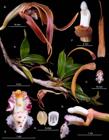
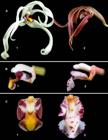
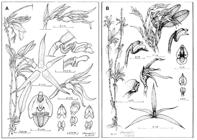
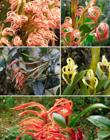

 LCDP by G.A. Pisso-Florez and J.S. Moreno based on the holotype.A. Habit. B. Flower. C. Dissected perianth, not flattened. D. Ovary, column and lip, lateral view. E. Adaxial view of lip. F. Column, oblique, ventral, and lateral views.
LCDP by G.A. Pisso-Florez and J.S. Moreno based on the holotype.A. Habit. B. Flower. C. Dissected perianth, not flattened. D. Ovary, column and lip, lateral view. E. Adaxial view of lip. F. Column, oblique, ventral, and lateral views.
 Photographs by G.A. Pisso-FlorezA. The “Camino Nacional”, a historical route traversing the southern portion of Puracé National Natural Park where the new species was found. Image of the plant in-situ. B. Lateral view (type specimen at 3204 m). C. Frontal view (individual observed at 3250 m).
Photographs by G.A. Pisso-FlorezA. The “Camino Nacional”, a historical route traversing the southern portion of Puracé National Natural Park where the new species was found. Image of the plant in-situ. B. Lateral view (type specimen at 3204 m). C. Frontal view (individual observed at 3250 m).
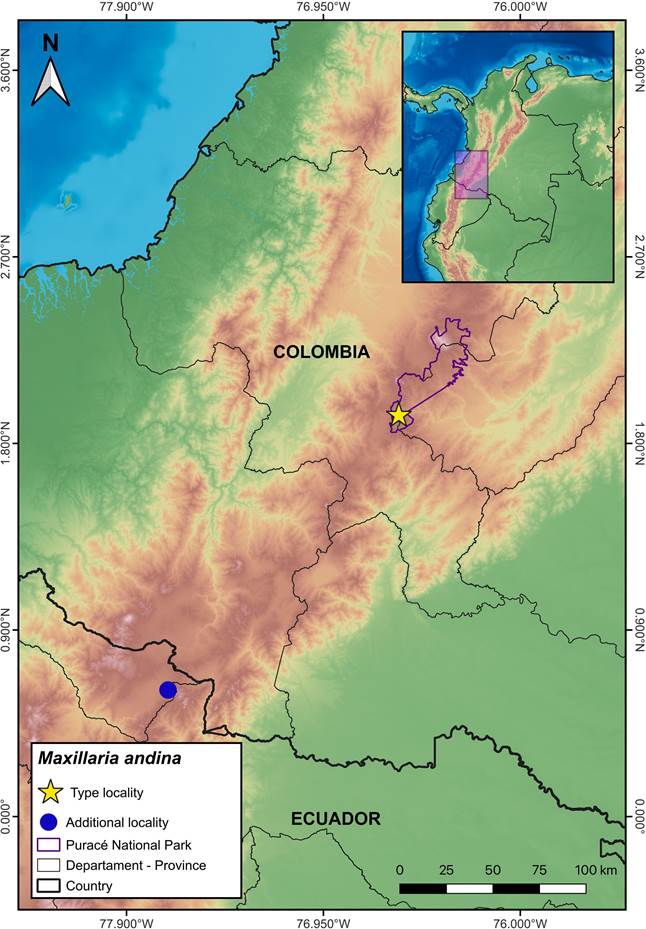 Names in capital letters indicate countries.
Names in capital letters indicate countries.
 LCDP by J.S. Moreno based on collected specimen by G.A. Pisso-Florez (GAP 392) in Puracé National Natural Park (CAUP!).A. Habit. B. Flower. C. Dissected perianth (one of the lateral sepals and one of the lateral petals omitted). D. Ovary, column and lip, lateral view. E. Adaxial view of lip. F. Column, oblique view. G. Anther cap and pollinia.
LCDP by J.S. Moreno based on collected specimen by G.A. Pisso-Florez (GAP 392) in Puracé National Natural Park (CAUP!).A. Habit. B. Flower. C. Dissected perianth (one of the lateral sepals and one of the lateral petals omitted). D. Ovary, column and lip, lateral view. E. Adaxial view of lip. F. Column, oblique view. G. Anther cap and pollinia.
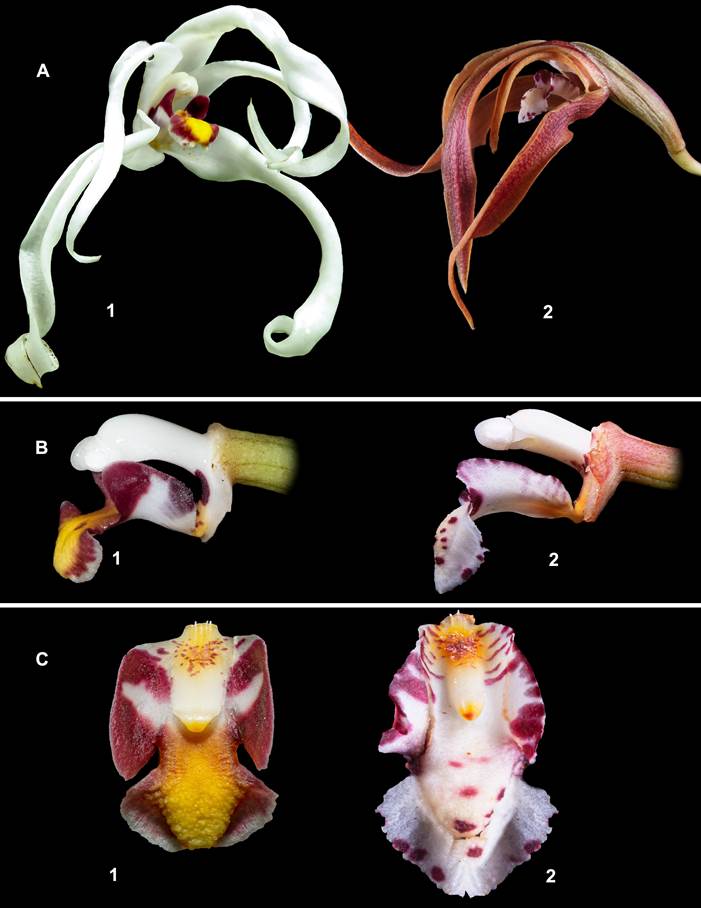 Photographs by G.A. Pisso-Florez and J.S. Moreno based on the holotype of M. andina and collected specimen by G.A. Pisso-Florez (GAP 392) in Puracé National Natural Park (CAUP!).A. Flowers. B. Ovaries, columns, and lips. C. Lips (not flattened).
Photographs by G.A. Pisso-Florez and J.S. Moreno based on the holotype of M. andina and collected specimen by G.A. Pisso-Florez (GAP 392) in Puracé National Natural Park (CAUP!).A. Flowers. B. Ovaries, columns, and lips. C. Lips (not flattened).
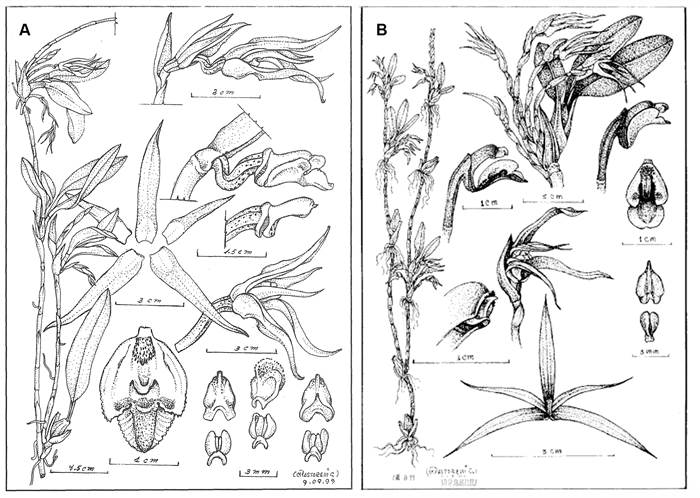 A. Drawing by M. Pastorelli A., Plate 693 in Icones Orchidacearum Peruviarum (
A. Drawing by M. Pastorelli A., Plate 693 in Icones Orchidacearum Peruviarum ( A. Photograph by Nelson Apolo in Yangana, Ecuador. B. Photograph by Alfredo F. Fuentes (Fuentes 8703, BOLV, HSB, LPB, MO) in Bolivia. C. Photograph by Thibaud Aronson in Peru. D. Photograph by Eric Hunt in Peru. E. Photograph by Brayan Coral Jaramillo from Putumayo, Colombia.
A. Photograph by Nelson Apolo in Yangana, Ecuador. B. Photograph by Alfredo F. Fuentes (Fuentes 8703, BOLV, HSB, LPB, MO) in Bolivia. C. Photograph by Thibaud Aronson in Peru. D. Photograph by Eric Hunt in Peru. E. Photograph by Brayan Coral Jaramillo from Putumayo, Colombia.